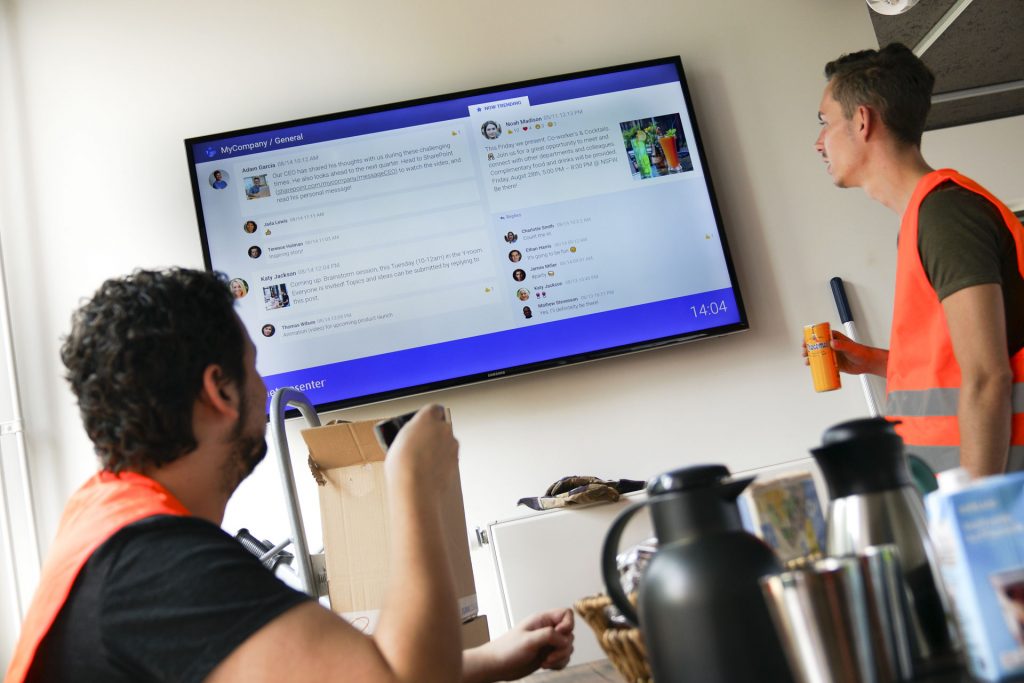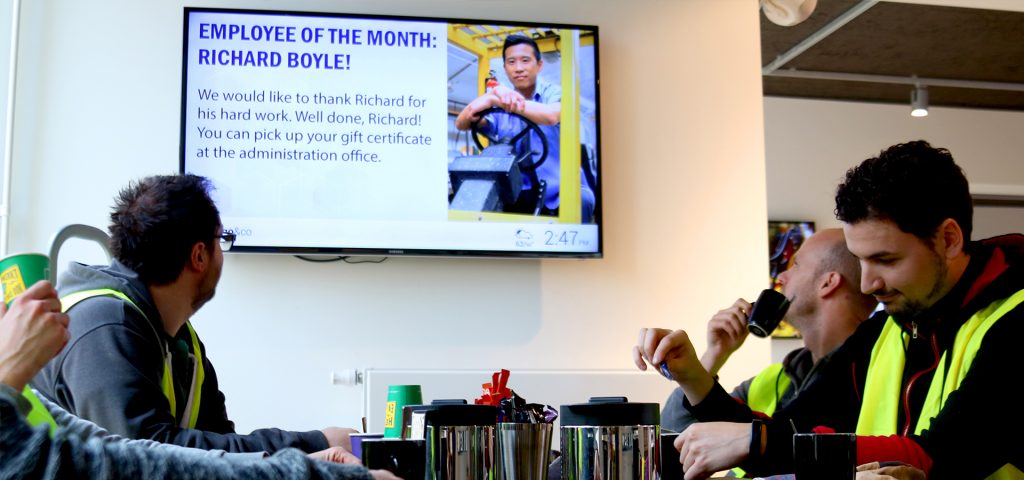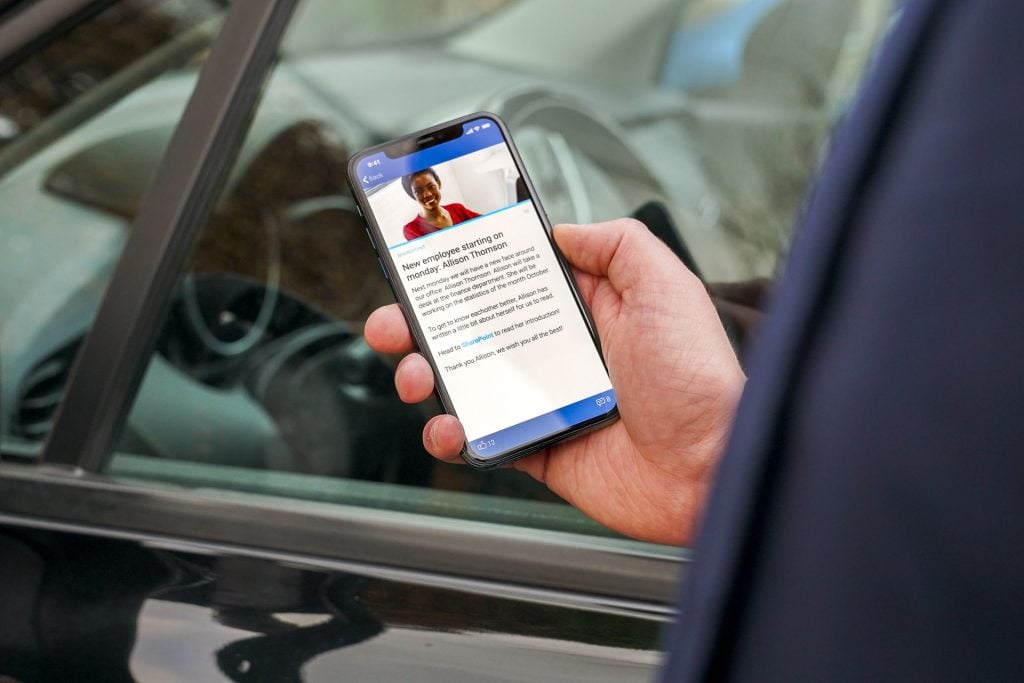The Dos and Don’ts of Communicating with Non-desk Employees
Estimated reading time: 7 minutes
Non-desk employees are essential to many organizations. In many cases, they’re frontline workers. Due to their work’s nature, they don’t always have access to a PC, which means they don’t automatically get organization-wide emails. Instead, they are with your customers, with patients, at the assembly line, or delivering parcels. Communicating with non-desk employees can be a very big challenge.
That’s why we asked our clients how they reach their non-desk employees using Netpresenter. Here are the dos and don’ts:
- Do: Fit Your Channels to Your Employees
- Do: Bring Employees in Touch with Each Other
- Do: Acknowledge Employees’ Work
- Don’t: Relying on Email
- Don’t: Overlook your Non-desk Employees
- Don’t: Overload of Irrelevant Information
1 – Do: Fit Your Channels to Your Employees
If you’re contemplating how to reach your employees best, the first thing you need to think about is which channels are most accessible to them. Most office workers work with PCs all day. That makes their PC the most logical channel to use for communication, using a corporate screensaver or Microsoft Teams, for example. But how do you reach employees who don’t sit behind their desks all day?

In that case, other channels are a lot more practical and designed for reaching people who don’t have access to a PC. Mobile devices such as smartphones and tablets, for example, can be very easily deployed to reach everyone in your organization. With an employee app, you have a central location for your company news on everyone’s device. With push notifications and even SMS notifications, you can grab the attention immediately if necessary. Ultimately, your communications should support your employees in doing their work successfully, so you should use channels that your employees already like using themselves.
2 – Do: Bring Employees in Touch with Each Other
Non-desk employees can become a bit isolated from the rest of their organization due to their work’s nature. For example, drivers or sales consultants who work alone or perhaps in a team may have little to no contact with other colleagues – even with people doing the same job on a different team. Too bad, since informal conversations are very important for your company culture and mutual cohesion.
Sandy Roozen of Automatic Signal also acknowledges the fact that non-desk employees may need some extra attention. “If you work at the office, you’re more likely to meet up with some colleagues and have a chat over a cup of coffee. You’re more likely to feel connected and to hear more about the organization. However, we wanted to give everyone the same feeling, especially colleagues who work in the field. We wanted everyone to know: we’re an important part of this company. Netpresenter certainly helped with that.”
It is important that you enable employees to interact with each other – after all, you don’t just want to publish information; you want to bring your employees in touch with each other. A virtual thumbs-up can sometimes be enough, but in other cases, you want to enable your employees to respond substantively or allow them to voice their opinions via a poll. A corporate app is ideal for this.
3 – Do: Acknowledge Employees’ Work
Some employees never see each other because they are always in the field, on the road, or working in different locations. It can be difficult to disclose what everyone contributes to the organization. This makes highlighting important work achievements regularly very important. It helps you share recognition and create solidarity. You show employees that everybody’s on the same team!

The Brooklyn Hospital Center regularly highlights a job well done. Eric Sommer, Senior Writer & Editor at Brooklyn Hospital Center, explains: “The TV and PC screens have had a huge effect on improving employee satisfaction and morale as well as creating a sense of community. When a team does something remarkable, the so-called small victories, I go over there, take a picture, go back to my office, and put the news and the picture on the screensavers and digital signage screens. The team then knows that everyone will know about their achievement, which makes them feel appreciated. It has an immediate ‘feel-good’ effect.
4 – Don’t: Relying on Email
How many emails do you receive every day? A survey by Wakefield Research found that about 38 percent of office workers receive so many emails each day that the resulting email fatigue causes them to consider leaving their jobs. Contributing to this email fatigue with organization-wide emails might not be the best idea. An employee communications platform that informs and engages your employees and encourages interaction (while completely bypassing email) may just make employees more productive and enthusiastic about their work(day).
Madelyn Swanepoel, Internal Communications and Employee Experience Specialist at BankservAfrica aims to move away from organization-wide email communication completely in the future. She uses the Netpresenter platform to reach about 400 colleagues with narrowcasting, screensavers, and the mobile app.
Madelyn: “I’ve found that people are tired of reading lengthy emails about nothing. With Netpresenter, they get news on the go. We’re no longer the email pusher or the post box. Netpresenter allows people to have a social media-like page of which they can feel proud. It enables everyone to go in with the touch of a button and read the news whenever they like. It’s seamless, easy access to information. It adds to the employee experience. And I’ve learned that when you create the experience, you get the engagement.”
5 – Don’t: Overlook your Non-desk Employees
Although 80 percent of employees work ‘desk-less’, 99 percent of technology applications are still focused on office workers. Moreover, in 89 percent of the cases, C-level or middle management decides which technology applications to implement. In short: the non-desk employees, the end users in this case, are overlooked.

However, your non-desk employees are the ones working in your front lines. They work with customers or patients daily, so they know what’s going on with key stakeholders. With this in mind, it might be a good idea to make sure that policies aren’t formed exclusively in meeting rooms or HQs: non-desk employees could give great input, too. Ask for their feedback on issues regularly, or even track the pulse of your organization with pulse surveys. That way, you’ll receive immediate feedback from your employees – wherever they are.
6 – Don’t: Overload of Irrelevant Information
The ease of sending messages and the proliferation of communication channels have created an environment of irrelevance and information overload. Each day, employees are flooded with communication of little relevance and low value. This overload of irrelevance will only lead to your employees ignoring your communication and getting irritated with any messages, as they will not have any added value.
Therefore, it’s important to ensure that information is always relevant to your employees. This can be done very easily with our smart targeting feature. Segment your employees into different audiences and send them personalized messages. You could even target a single employee – everything is possible.
Our customer Barenbrug makes grateful use of this feature. Barenbrug has offices and research facilities in over twenty-two countries, and more than eight hundred employees. Mirella van de Sant, Global Marketing Director at Barenbrug explains: “With Netpresenter we’re now communicating more. We have set up a local channel for each country, and a global channel with information that is relevant to everyone. That way, everyone gets information that is relevant, and they can also follow the global news.”
Could you use some help communicating with non-desk employees? Download our free guide ‘How to communicate effectively with non-desk employees‘. Or schedule a free demo or call today. We are happy to show you what Netpresenter can do for your organization!

